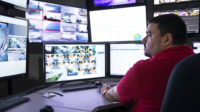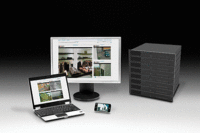When we think about video surveillance, it tends to be all about the camera: resolution, field of view, wide dynamic range. Let’s not forget about audio, which can be a force multiplier when used in conjunction with video. Often, the simple act of having an operator speak to someone who’s in the field of vision via a speaker (whether built into the camera or installed separately) can make a great difference in the outcome of a situation.
“Audio-enabled systems are a solid additive to a proactive security plan,” says Robert Van, director of operations, National Maintenance Group, for G4S Technology, based in Omaha, Neb.
Bill Thorpe, president of Atlanta-based Remote Security Services (RSS), can attest to the power of a combined audio-video solution. A client of RSS with 13 work centers in the Atlanta area was experiencing what Thorpe calls “persistent theft” from the areas where service vehicles were parked at the end of each day. Among the items thieves targeted were catalytic converters, copper and tools. These thefts added up to a loss of about $600,000 in 2010. In January 2011, RSS installed an audio-enabled video system in each of the affected locations, allowing someone in a remote location to speak to would-be thieves when they were spotted on camera and let them know they were being watched. As a result, the company’s losses were dramatically lower in 2011, according to Thorpe.
“They still had 28 intrusions that year, but they were able to limit their losses to $7,000,” he says. “They had people running around in there, but they weren’t able to get anything. That’s the kind of impact these systems can have.”
To read about how G4S has beefed up customers’ security with audio-enabled video systems, see the related story “Talking Success” on page 110.
Cameras themselves work just fine. We’re used to their presence, and when we see them in our everyday lives, most of us probably don’t give a second thought to whether there is a person on the other end of the video feed.
Applications
There are a wide range of vertical markets and applications that are well-suited for audio-enabled video systems, Van says. Vehicle dealerships, building and construction supply storage, and schools are examples where there are very fixed hours of occupancy — as well as all types of remote facilities, Van says.
“Often these systems are used in applications where the local authorities may be hindered by response times, so the client’s first objective is to provide motivation for a trespasser to leave the area, and apprehension (while preferred), is secondary,” VAN says. “The client may also be concerned about what kind of damage the trespasser may cause (not only to valuables, but also to trespasser as well, by getting injured or electrocuted) prior to the arrival of authorities, such as at utility sites.”
One trend Rob Simopoulos, president of Scarborough, Maine-based Advance Technology, has seen is audio-enabled systems used as an alternative to traditional intrusion detection. The thought is that by detecting someone before they enter the premises, operators can perform a talk-down and prevent the intrusion in the first place.
“With intrusion, you don’t detect someone until they’re inside, but if by setting up a perimeter of 20 feet or so, you detect them at that moment and give yourself time to prevent intrusion,” he says. “With break-ins, it’s all about time.”
Remote substations also are an emerging market. “Power companies are ramping up their security because substations are suddenly a big topic for security folks,” he explains.
Analytics
As with any installation, familiarity with the site is paramount to a successful audio-enabled video system. Walls, doors, furniture and equipment — whether planned or in place — can impact audio coverage, as can background noise in existing buildings,VAN says.
“A larger number of smaller speakers is often preferred to a large central system for audio quality, as well as minimizing the impact on neighboring properties,” he says.
Camera considerations are also the same whether the system is audio-enabled or not, Thorpe says. “In general, you need clear views. It sounds simple, but sometimes the camera view is not unobstructed or there’s not enough lighting,” he says.
These considerations are especially important because cameras are used as detection tools in audio-enabled video systems to trigger an alert that lets an operator know an audio response may be necessary.
“A lot of times people are looking to steal scrap metal or copper, so we’d have a number of analytic cameras in position to look for a human or a vehicle in the camera’s view to send a video clip — pre- and post-event — to the monitoring station to perform a talk-down to attempt to get a person to leave the premises,” Thorpe describes.
Because these types of systems rely heavily on analytics, installers and integrators could encounter challenges with a particular site, especially if there is lot of motion in a scene or if the camera is too far from the area it is monitoring.
“If you have a client site with a busy street behind it, the analytic software has to be more sophisticated than motion detection; the sensitivity settings need to be tweaked up and down depending on the time of day and the level of motion to address the camera’s ability to throw an alarm,” Thorpe says. “We’ve learned what analytics are capable of and what’s not possible. The ability to throw an alarm, say, 100 yards is minimized. It also comes down to camera lens selection, distance and the sensitivity of the settings. Those are things we wrestle with when we turn up to fight.”
In short, placing enough cameras in the appropriate locations is paramount to ensuring that the analytics will operate properly.
“When you talk about analytics, you have to have appropriate coverage for the area you’re trying to cover. If it’s a yard with construction equipment behind fences, one way would be to mount cameras on the side of the building. That kind of general coverage might be OK because it’s a large-scale area,” Simopoulos says. “With an auto dealership, sometimes people steal catalytic converters so cameras have to be mounted on the fence line, behind the vehicles. Otherwise, you could have a situation where the camera never saw them and missed the activity.”
Response
Integrators stress the importance of having a live person speak rather than playing recorded messages. “When it’s a live voice, we know it, don’t we? Eight or so years ago, we used sirens, but that doesn’t speak to active management where someone is watching me and talking to me,” Thorpe says.
Not surprisingly, a live person is a much more effective deterrent. “People will often leave if they know they’ve been detected, and if they don’t leave, we dispatch the authorities. That’s considered a verified alarm because we have a description, so we get a priority response,” Simopoulos says.
So how do operators know when they have detected a live person?
“Often operators will use specific physical descriptors of the trespasser, which often provides additional motivation for the trespasser to leave the site,” VAN says.
The more descriptive operators are, the more likely — and more quickly — a person is to leave the area.
“When our operators do a talk-down, we want it to seem as real as possible, so they describe the perpetrator, like ‘You in the red hat and blue shirt,’ so they know it’s real and they’re being watched and that if they don’t leave, authorities will be on the way,” Simopoulos says.
For many locations, such as electrical substations or vehicle pools, that kind of messaging is the first option. For others, such as car dealerships, operators need to walk a fine line.
“A car dealership wants you to window shop or drive through on a Sunday when they’re closed, so their talk-down might be different, something like ‘Welcome to King Motors. We’re closed right now, but feel free to walk around. This facility is monitored 24 hours a day,’” Simopoulos describes.
Retail establishments are another case where messaging policies must allow for some latitude.
“When monitoring a retail store’s glass front after hours, you want to prevent someone from throwing a brick through it, but people also window shop. So we offer a soft challenge, ‘Welcome. This business is closed right now, but we’re happy to direct you to the website or have someone call you.’ In that case, we use duplex audio with a PA speaker and microphone,” Thorpe says. “Typically, there are two to three progressive challenges, but it’s variable from customer to customer.”
If nothing else, the main thing to consider with audio-enabled video systems is flexibility in terms of system design and installation, as well as policies and procedures for responding, Thorpe says.
“There’s not a cookie-cutter method for these types of systems. No two sites are the same, so each customer’s needs impact how you implement the system,” Thorpe says.
Talking Success
According to Robert Van of G4S Technology, the company has seen the benefit of audio-enabled video systems with both listen-in and talk-down services.
One large hotel chain’s location had a domestic dispute occur in its lobby. The clerk considered calling the police, but was concerned that that could escalate the situation and pushed the panic button instead.
“We were able to listen in to the situation and contact authorities to respond, all the while giving them real-time intelligence on the situation,” Van says.
While that was a listen-in situation, G4S also has had success providing talk-down service to high-end auto dealerships with expensive cars on its lot. In this case, the problem wasn’t with theft, but with people coming onto the lot to have their photo taken in front of a luxury car. While this seems harmless enough, they often would inadvertently scratch the paint or cause some other kind of minor damage, which can be expensive to repair on a luxury vehicle. Van says the talk-down service has curtailed these activities and prevented further damage.
“Almost nightly, we’re performing successful talk-downs at these sites. We share this information with the client in order to demonstrate the value of the service,” Van says.







